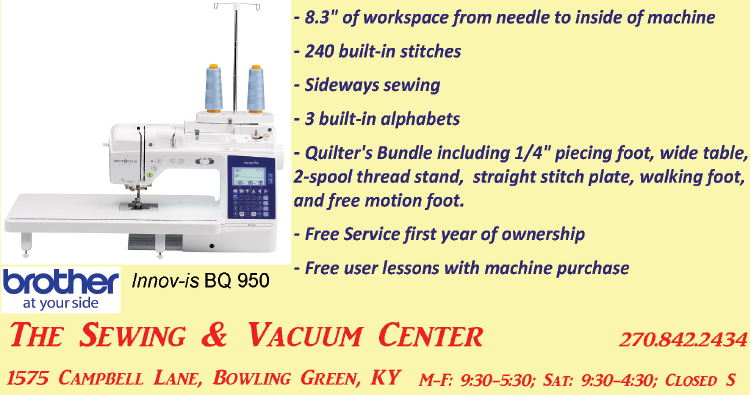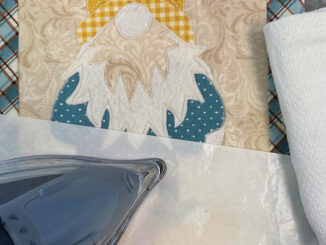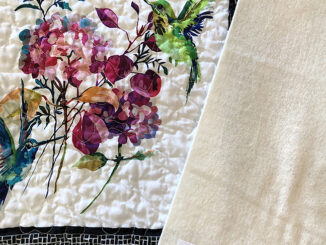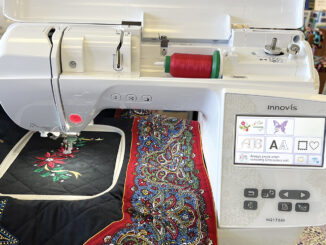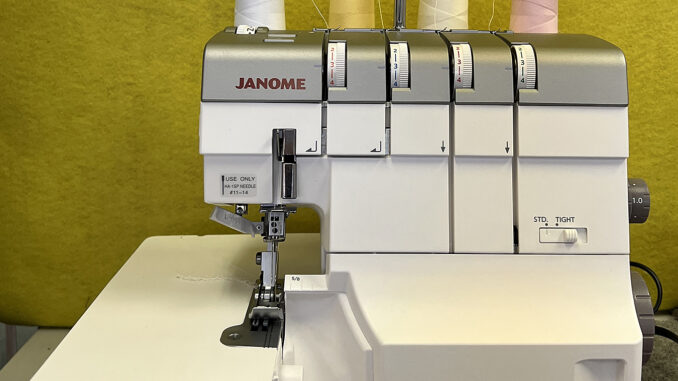
Sergers and coverstitch machines are good additions to the sewing room. Neither machine will replace your sewing machine, but each brings special functions to your stitching experience.
First, the serger. Sergers are special purpose machines that make professionally finished seams. These seams are the same as found on ready-made garments. Depending on the model, the serger will use three or more threads to enclose the raw edge of the seam while cutting the seam allowance away. Sergers can stitch up to 1700 stitches per minute, making this a very quick sewing method. The serger does not use bobbins – instead, the serger has “loopers” and multiple needles, plus a cutting knife to produce the covered seam.
Clean-finishing seam allowances are the most popular use of sergers, although they can do more stitching, such as roll hemming, blind hemming and gathering.
The serger works especially well with knit fabrics, which are often difficult to stitch on a sewing machine. Most sergers have built-in stretch which makes handling knits very easy. The looper eyes are also larger than those of sewing needles and can handle thicker, decorative threads easily.
When purchasing a serger, consider the following:
Number of threads used: Most popular are the four-thread models which give more stitching options.
Threading ease: Sergers thread very differently from a traditional sewing machine. You may work with three or more spools of thread between the needles and loopers. Ask how the loopers are threaded; this is the most challenging part of readying the serger for stitching. Some sergers have self-threading loopers, which is nice, but also adds significantly to the price.
Differential feed: This is an adjustment to the feed dogs which controls how the fabric is fed. This can help eliminate puckers, stretching or rippling in seams. The differential feed can also be adjusted to gather fabric, if needed.
Accessories: The more accessories included with your machine, generally the better buy you are getting. It is more expensive to purchase feet separately. The model you are looking at may not use all feet that are available. Some sergers will have a beading foot, blind hem foot, fabric separator, etc.
The coverstitch machine is used to make a professional-looking hem on garments. Hems on T-shirts are an excellent example of this stitching. Trims can also be applied to flat seams. As with the serger, the coverstitch machine works especially well with knit fabrics where stretchy seams are needed. One, two or three needles can be used with the thread looper on the bottom to create the stitch. The coverstitch machine does not trim when stitching as the serger does.
If you are thinking of purchasing a coverstitch machine, consider the following:
Maximum stitch width which can affect the look of the hem. Check on the spacing of the needles.
Maximum stitch speed is how fast the machine will stitch.
Number of needles allows for rows of parallel stitching. How many depends on the look and type of hem you need. Generally, two needles are used for most hemming.
Free arm allows for easy stitching around sleeves and necklines.
Which machine is best for the sewing room? Only you, the customer, can determine that. First, you need a good sewing machine as both these machines are specialty machines with limited use. Neither of these will take the place of a sewing machine. The serger can do several things, including rolled hemming and stitching seams. The serger also has a knife that trims the seams as you stitch. The coverstitch ONLY hems. If you do a lot of hemming, this is a great addition for your sewing room.
No matter which type machine you decide to purchase, do make sure the dealer provides lessons on the machines. At The Sewing and Vacuum Center, we provide one-on-one lessons free with the purchase of our machines. These lessons are good for as long as you own the machine. Come in and see our selection of machines!
-submitted by The Sewing and Vacuum Center

